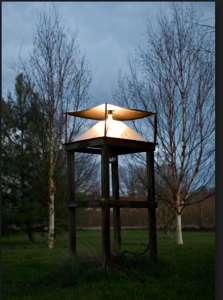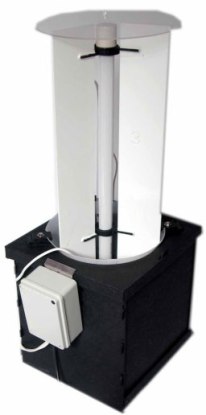I think that even those of us who are not entomologists are familiar with the attraction that insects, particularly moths, have for light. The great Sufi philosopher Bahauddin Valad (1152-1231) wrote the following lines
a candle has been lit
inside me,
for which
the sun
is a moth.
In Shakespeare’s The Merchant of Venice (1596), Portia famously declaims “Thus hath the candle singed the moath.”
It may thus come as a bit of surprise to realise that ‘modern’ entomologists were quite slow to develop bespoke traps that took advantage of this aspect of insect behaviour. That said, according to Beavis (1995) the Roman author Columella (Lucius Junius Moderatus, 4-7 AD), describes a light trap to be used to protect bee hives from wax moth attacks. A pretty much identical trap was still being used in 1565 (Gardiner, 1995) although he erroneously calls it the first light-trap. As far as I can tell the early ‘modern’ Lepidopterists used the white sheet technique, still used today, where a light source such as a paraffin lamp (nowadays an electric light or powerful torch) was suspended above or behind a white sheet, from which the intrepid entomologist collected specimens of interest that come to rest on the sheet. This can be very efficient but does require the entomologist to be ‘on duty’ throughout the trapping
The white sheet technique.
period, although on a fine night, with good companionship and an ample supply of beer, or other alcoholic beverage, it can be a very pleasant way to spend a long evening 😉
The earliest published reference to a modern bespoke light trap that I have been able to find is a patent from 1847 for a modified beehive which includes a light trap to lure wax moths away from the main part of the hive (Oliver Reynolds, 184, US Patent5211; http://www.google.com/patents/US5211).
The modified Reynolds Beehive incorporating moth trap.
The second published reference to a bespoke light trap is again one designed to control wax moths and is described in a patent application by J M Heard dated 1860. In this case as far as I can make out the lamp is actually glass coated with a phosphorescent material rather than using a candle or oil flame.
“The basin A, is supplied with a requisite quantity of molasses or other suitable substance to serve as a bait, and the inner sides of the glass plates c, of the lamp C, are covered with a mixture of phosphorus and oil or phosphorus combined with any suitable substance to form a cement, or a stick E, may be coated with the cement, said stick being passed through the tube e, into the lamp, as shown plainly in Fig. 1. The insects decoyed by the light and attracted by the bait, strike against the inclined glass plates c, and fall into the basin A. By having the plates c, inclined the insects are made to fall through the opening b, into the basin and said opening is permitted to be comparatively small and the cover a, of the basin in connection with the cover D, of lamp protect perfectly the bait from sun and rain, thereby protecting an unnecessary waste of the same. During the day the phosphorus of course is not needed unless it be cloudy, but the device is chiefly efficacious at night as the visits of the insects are mostly nocturnal.”
So whilst beekeepers and agriculturalists were busy using traps to attract moths to kill them what were the lepidopterists doing? It appears that they were using whole rooms as light traps as described here by H T Stainton in 1848.
A later Victorian entomological ‘how to’ book, added instructions of how to use gas and paraffin lamps outside, with the lepidopterist standing ready with his net (Greene, 1880).
The 20th Century was however, when we see the birth of the light traps as we know them today. First on the scene was the Rothamsted Trap, developed by the great C B Williams, which was
The electric ‘fixed’ Rothamsted Trap.
The ‘portable’ Rothamsted Trap – Williams (1948)
developed from earlier versions that he used in the 1920s and 1930s, in Egypt and England (Williams, 1924, 1935).
Rothamsted trap in action
Apparently the first electrical light trap to use an ultra-violet light was made in 1938 (Barratt, 1989) and used in the 1940s (Fry & Waring, 2001) but it was not until 1950 that the first commercially available version was produced (Robinson & Robinson, 1950).
The Robinson Trap – very popular and ideal for use in gardens where there is easy access to a mains supply.
Strangely, considering that the Americans had been first on the scene with patented light traps it was not until 1957 that the Pennsylvanian and Texas traps appeared on the scene (Frost, 1957) closely followed by the Texas traps (Hollingsworth et al., 1963). These traps used fluorescent tubes instead of bulbs and were particularly good at catching beetles, moths and ants. The Texas trap and the Pennsylvania trap were essentially the same, the main difference being that the Pennsylvania trap has a circular roof to prevent train entering the killing bottle. As Southwood (1966) somewhat tongue in cheek says, this may reflect the differences in the climate of the two states 😉
The Pennsylvanian Light Trap.
In the 1960s the Heath Trap appeared on the scene (Heath, 1965). This was billed as being extremely portable, being able to be carried in a back pack and also able to be run either from a mains supply or from a 12 volt battery.
The Heath Light trap.
Less expensive and more portable is the Skinner trap, (designed by Bernard Skinner in as far as I can make out in the early 1980s, please let me know if you know exactly) which comes in wooden and aluminium versions and is collapsible, so that if needed, several can be transported at once. It comes in both mains and battery versions.
The Skinner light trap – relatively inexpensive and very portable.
An interesting combination of light and odour being used to attract and trap insects, in this case to ‘control’ them, is the Strube Stink bug trap. This is an American invention and is used to protect US householders against the the Brown Marmorated Stink Bug, Halyomorpha halys, an invasive species from Asia which appears to have developed a propensity to overwinter in people’s houses. I remember a few years ago that we in the UK were warned that it might cross the channel from France; this resulted in lurid headlines in the ‘Red Top’ newspapers with wording like ‘stench spraying insect’ being used 😉
This appears to be a very effective trap; all the reviews I have read praise it highly, so if the Brown Marmorated Stink Bug does make it to the UK, the Strube trap will be the one to buy!
References
Frost, S.W. (1957) The Pennsylvanian light trap. Journal of Economic Entomology, 50, 287-292.
Fry, R. & Waring, P. (2001) A Guide to Moth Traps and their Use. Amateur Entomologist, Orpington, Kent.
Gardiner, B.O.C. (1995) The very first light-trap, 1565? Entomologist’s Record and Journal of Variation, 107, 45-46
Greene, J. (1880) The Insect Hunter’s Companion. W. Swan Sonnenschein & Allen, London.
Heath, J. (1965) A genuinely portable MV light trap. Entomologist’s Record and Journal of Variation, 77, 236-238.
Hollingsworth, J.P., Hartstock, J.G. & Stanley, J.M. (1963) Electrical insect traps for survey purposes. U.S.D.A. Agricultural Research Service 42-3-1, 10 pp.
Robinson, H.S. & Robinson, P.J.M. (1950) Some notes on the observed behaviour of Lepidoptera in the vicinity of light sources together with a description of a light trap designed to take entomological samples. Entomologist’s Gazette, 1, 3-20
Southwood, T.R.E. (1966) Ecological Methods. Chapman & Hall, London
Stainton, H.T. (1848) On the method of attracting Lepidoptera by light. The Zoologist, 6, 2030-2031
Williams, C.B. (1924) An improved light trap for insects. Bulletin of Entomological Research, 15, 57-60.
Williams, C.B. (1935) The times of activity of certain nocturnal insects, chiefly Lepidoptera, as indicate by a light-trap. Transactions of the Royal Entomological Society of London B, 83, 523-555.
Williams, C.B. (1948) The Rothamsted light trap. Proceedings of the Royal Entomological Society of London A, 23, 80-85.
Post script
There are of course more light traps out there, many being variations of those described above, or for specific insect groups such as mosquitoes or aquatic traps for Cladocera (water fleas). Many ‘home made’ traps also exist, such as the ‘portable’ one I made for use on the field course that I used to run at Silwood Park.
The Leather Light Trap
I used a rechargeable battery lantern, but other light sources would also work. In retrospect I should have painted the Perspex black so that only the ‘entrance’ funnels emitted light. There was a tendency for insects to sit on the outside of the trap rather than enter it.
A useful link for those wishing to make their own traps can be found here http://www.theskepticalmoth.com/techniques/light-traps/ and Fry & Waring (2001) also has some very useful hints and tips.
















This is an amazing article- is there new insight on how moths are attracted to light?
LikeLike
Not that I know of
LikeLike
I am trying to get hold of the Robinson and Robinson 1950 article in the Entomologist’s gazette which describe their work on trapping, do you know anybody who might help with this.
” Some notes on the observed behaviour of Lepidoptera in the vicinity of light sources together with the description of a light trap designed to take entomological samples. Entomologists Gazette 1, 3–20.”
LikeLike
The only person I can think of who might have a copy outside a library is John Badmin jbadmin@btinternet.com – he may be able to help
LikeLike